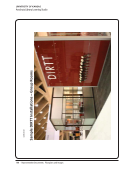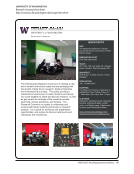SPEC Kit 327: Reconfiguring Service Delivery · 15
or improvements to the technology offered, or patron-
friendly improvements such as comfortable reading
room furniture or more group study rooms.
Driving Factors in Service Delivery
Reconfigurations
In addition to looking at the types of reconfigurations
that ARL libraries have experienced in the past three
years, the survey asked respondents to consider the
driving factors that served as the impetus for the re-
configurations that were described. The survey listed
a broad range of factors that reflected external, more
concrete drivers such as changes in physical facilities,
financial or staff resources, and/or the availability/
application of new technologies internal, less tan-
gible drivers such as changes in service philosophy
or responding to user demands and drivers beyond
the library such as collaborating with a partner out-
side the library or outsourcing delivery of a particular
service. Finally, respondents were provided the op-
portunity to briefly describe other factors that might
have influenced the reconfigurations they had de-
scribed (see questions 4 and 19). In the vast majority
of cases, respondents indicated that more than one of
these factors were significant drivers in the decision
to reconfigure library services. See Figure 1 below for
the percentage of responses for each driving factor.
Physical or Philosophical Change
Given the current economic downturn, changes in
financial and/or staff resources might be expected
to be the most significant driver in the decision to
reconfigure library services. Based on the responses
received, though, ARL libraries are driven most by a
changing service philosophy to provide better cus-
tomer service. Just under three-quarters of the libraries
that responded to this question indicated that a change
in service philosophy was a driving factor in reconfig-
uring services. Additionally, slightly more than half of
the responding libraries indicated user demands are a
driving factor. Frequently, descriptions of a change in
service philosophy accompanied the physical recon-
figurations reported, such as creating an information
commons/research commons space approach, pro-
viding centralized, one-stop service points for users,
making services more user friendly, and making the
best use of librarian time by changing to a just-in-time
model as opposed to a just-in-case model. A change
in service philosophy could also be expressed in a
library’s internal organization, documentation, or rou-
tines. One responding library noted a changed service
philosophy in its development of baseline expectations
of levels of reference service in various subject areas so
that service desk staff will know when to refer users
to subject specialists.
0
10%
20%
30%
40%
50%
60%
70%
80%
Figure 1. Driving Factors in Decisions to Reconfigure Service Delivery
Other
factor Opportunity
for outsourcing
service
delivery Opportunity
for collaboration
with
a
partner Availability/ application
of
new
technology
Change
to
library
financial
resources
Physical
change
to
a
building
or
facility
Changes
in
library
staff
resources
User
demands Change
in service philosophy
or improvements to the technology offered, or patron-
friendly improvements such as comfortable reading
room furniture or more group study rooms.
Driving Factors in Service Delivery
Reconfigurations
In addition to looking at the types of reconfigurations
that ARL libraries have experienced in the past three
years, the survey asked respondents to consider the
driving factors that served as the impetus for the re-
configurations that were described. The survey listed
a broad range of factors that reflected external, more
concrete drivers such as changes in physical facilities,
financial or staff resources, and/or the availability/
application of new technologies internal, less tan-
gible drivers such as changes in service philosophy
or responding to user demands and drivers beyond
the library such as collaborating with a partner out-
side the library or outsourcing delivery of a particular
service. Finally, respondents were provided the op-
portunity to briefly describe other factors that might
have influenced the reconfigurations they had de-
scribed (see questions 4 and 19). In the vast majority
of cases, respondents indicated that more than one of
these factors were significant drivers in the decision
to reconfigure library services. See Figure 1 below for
the percentage of responses for each driving factor.
Physical or Philosophical Change
Given the current economic downturn, changes in
financial and/or staff resources might be expected
to be the most significant driver in the decision to
reconfigure library services. Based on the responses
received, though, ARL libraries are driven most by a
changing service philosophy to provide better cus-
tomer service. Just under three-quarters of the libraries
that responded to this question indicated that a change
in service philosophy was a driving factor in reconfig-
uring services. Additionally, slightly more than half of
the responding libraries indicated user demands are a
driving factor. Frequently, descriptions of a change in
service philosophy accompanied the physical recon-
figurations reported, such as creating an information
commons/research commons space approach, pro-
viding centralized, one-stop service points for users,
making services more user friendly, and making the
best use of librarian time by changing to a just-in-time
model as opposed to a just-in-case model. A change
in service philosophy could also be expressed in a
library’s internal organization, documentation, or rou-
tines. One responding library noted a changed service
philosophy in its development of baseline expectations
of levels of reference service in various subject areas so
that service desk staff will know when to refer users
to subject specialists.
0
10%
20%
30%
40%
50%
60%
70%
80%
Figure 1. Driving Factors in Decisions to Reconfigure Service Delivery
Other
factor Opportunity
for outsourcing
service
delivery Opportunity
for collaboration
with
a
partner Availability/ application
of
new
technology
Change
to
library
financial
resources
Physical
change
to
a
building
or
facility
Changes
in
library
staff
resources
User
demands Change
in service philosophy






















































































































































































































